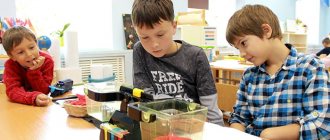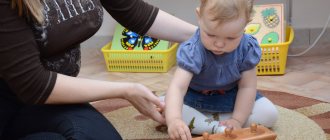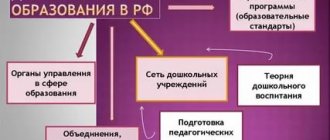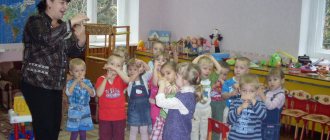System history
Maria Montessori was born on August 31, 1870. She was the first female doctor in Italy, as well as a psychologist, teacher, and scientist.
In 1896, Maria worked in a children's clinic, and her attention was drawn to the unfortunate mentally retarded children who, not knowing what to do, wandered aimlessly along the echoing hospital corridors. Observing their behavior, Maria concluded that this is the result of a lack of incentives for development, and that every child needs a special developmental environment in which he can learn something interesting for himself. Focused and deeply engaged in psychology and pedagogy, Maria tried to develop her own methods of raising and developing children.
On January 6, 1907, Maria Montessori opened the “Children's House” in Rome, where the pedagogical system she created was used for the first time. Using trial and error, Maria prepared sensory materials that stimulated children's cognitive interest. Since 1909, Montessori's books began to spread around the world, and in 1913 they reached Russia. In 1914, the first kindergartens began to open according to the Maria Montessori system, but they were closed when the Bolsheviks came to power. The return of the Montessori method to our country took place only in 1992.
Based on knowledge about the characteristics of the physiological, mental and psychological development of children, Maria Montessori came to the conclusion that education is not so much the responsibility of the teacher as a natural process of the child’s development.
Stages of development
Maria Montessori believed that as children grow older, they go through certain levels of development. To make learning as useful and enjoyable as possible, the lesson program must take into account the characteristics of each stage.
First level
- from birth to 6 years. The baby becomes an explorer who is already striving for independence. The adult acts as an observer and ally. He helps create a comfortable environment and learning environment, and then only supervises the learning process.
Second level
- from 6 to 12 years. The children experience physical changes: their baby teeth fall out, and their legs and torso grow evenly. A “herd instinct” and the desire to show oneself appear. Along with the body, imagination and intellect actively develop. At this stage, students need to be explained that it is normal to have their own opinion, even if it differs from the judgments of others. At the same time, children are told how to behave in society.
Third level
- from 12 to 18 years. It is associated with puberty and adolescence. This stage of development is the most unstable. Children's sense of justice and self-esteem intensifies. They are actively looking for their place in the world, are sensitive to their appearance and want to be liked. At this age, close attention is paid to the creative potential of a teenager.
Fourth level
- from 18 to 24 years old. Dr. Montessori believed that if a child is developed according to her method, then by the time he reaches adulthood he has already turned into a full-fledged personality with the makings of a leader. In general, she characterized this period as the need to receive money for her work. The young specialist strives for financial independence.
The essence of the Montessori method
The Montessori method is a unique author’s system of self-development and self-education for children. The key attention here is paid to the development of fine motor skills, senses (vision, hearing, taste, smell, touch), as well as to nurturing independence in the child . There are no uniform programs and requirements; each child is provided with an individual pace. Every child is free to do what he likes. Thus, he “competes” with himself, gaining self-confidence, as well as fully assimilating the material.
The key principle in Montessori pedagogy is “Help me do it myself . That is, an adult must figure out what the child is interested in, provide him with an appropriate environment for activities and teach the child to use it. An adult helps the child to reveal the abilities inherent in him by nature, as well as to go through his own path of development. Let us note that pupils of the Montessori system are inquisitive children, open to acquiring knowledge. They grow up independent, free, and know how to find their place in society.
Goals of lessons using the Montessori method by age
The approach provides education for children from birth to secondary school, while the focus of attention, and therefore the techniques used in a Montessori environment, depend on the age of the child. Below we offer a table that outlines the main goals of Montessori education for children at different age stages.
| Child's age | Goals of Montessori education | Basic techniques and formats |
| From birth to three years |
|
|
| From three to six years |
|
|
| From six to twelve years |
| A comprehensive study of the experience accumulated by humanity and more specialized classes devoted to the study of the universe, wildlife, humanity, language and the world of exact sciences |
| Twelve to fifteen years old |
| Unfortunately, the methodology was not developed by Maria Montessori herself, however, followers of the approach actively use group work, scientific discussions, individual educational plans and practical work for the personal and professional development of adolescents |
Even from this table it is clear that the development of a harmonious personality must certainly begin at a very early age, which is why Montessori teaching methods are used primarily in preschool institutions, because in the future Montessori graduates are much more adaptive and achieve better results in schools of a variety of approaches.
First of all, the essence of the Montessori method for children of all ages is education based on the individual strengths and interests of each child. Montessori education encourages children to explore the world around them and find their own place in this world.
Basic principles of the Montessori system
- Child activity. In teaching a child, an adult plays a secondary role, being not a mentor, but an assistant.
- Freedom of action and choice of the child.
- Older children teach younger ones. At the same time, they themselves learn to take care of their younger ones. This is possible because, according to Montessori pedagogy, groups are formed from children of different ages.
- The child makes decisions independently.
- Classes are conducted in a specially prepared environment.
- The adult's task is to interest the child. Then the baby develops on his own.
- In order for a child to develop fully, it is necessary to provide him with freedom of thinking, action and feelings.
- You should not go against the instructions of nature, you need to follow these instructions, then the child will be himself.
- Criticism is unacceptable, prohibitions are unacceptable.
- The child has the right to make mistakes. He is quite capable of reaching everything on his own.
Thus, the Montessori system stimulates in the child the desire to develop the potential inherent in him, to self-learning and self-education. In this case, the responsibility of organizing the children’s activities falls on the shoulders of the teacher, while offering assistance exactly to the extent necessary for the child to become interested. So, the main components of Montessori pedagogy, allowing children to realize their own path of development, are:
- Educator
- Specially prepared environment
- Didactic material
The role of the adult in the system
It may seem that the role of an adult in this technique is insignificant, but this is only at first glance. The teacher must have wisdom, natural instinct, and experience in order to penetrate the system. He must carry out serious preparatory work to create a real developmental environment, as well as provide students with effective didactic material.
Maria Montessori believes that the main task of an adult is to help the child collect, analyze and systematize his (the child’s) own knowledge. That is, adults do not convey their own knowledge about the world. It is understood that the teacher must carefully observe the actions of the children, identify their interests, inclinations, and provide tasks of varying degrees of difficulty with the didactic material that the child himself chooses. In this case, it is assumed that the adult should be on the same level with the pupil - that is, sitting on the floor or squatting next to him.
The work of a teacher is as follows. First, he monitors what material the child chooses or helps him become interested. Then he shows how to cope with the task at hand, while being as laconic as possible. After which the child plays independently, he can make mistakes, but at the same time come up with new ways to use the selected material. Such creative activity of a child, according to Montessori, allows him to make great discoveries . The adult’s task is not to interfere with these discoveries, since even a small remark can confuse the baby and prevent him from further moving in the right direction.
The role of the developmental environment in the Montessori system
The most important element in Montessori pedagogy is the developmental environment. One might even say it is a key element. Without it, the technique cannot exist. A properly prepared environment helps the child develop independently without parental care and teaches him to be independent. Children have a great need to understand the world around them; they want to smell, touch, and taste everything around them. A child’s path to intellect lies through the senses, so sensation and cognition merge together for him. The right environment is an environment that meets the child's needs . The development process of children should not be accelerated, but you also need to be very careful to prevent the child from losing interest in a particular activity.
The developmental environment is built according to a strictly defined logic. Traditionally, there are 5 zones:
- Exercise zone in daily life. Here the child learns how to handle his things and how to take care of himself.
- Native language zone. Allows you to expand your vocabulary, get acquainted with letters, phonetics, and understand the composition and spelling of words.
- Sensory education zone. Develops the senses, provides the opportunity to study the shape, size, size of objects.
- Space Zone. Introduces the world around us, the basics of anatomy, botany, zoology, geography, astronomy, and physics.
- Math zone. Teaches understanding of numbers, order when counting, composition of numbers, as well as basic mathematical operations - addition, subtraction, multiplication and division.
There are no tables in the room, there are only small tables and chairs that can be moved at your discretion, as well as rugs. Children can lay them out where they feel comfortable.
Pedagogical system of Maria Montessori article on the topic
Pedagogical system of Maria Montessori.
Today, the pedagogy of Maria Montessori is one of the most popular methods of child development, which combines seemingly incompatible things: freedom and discipline, exciting play and serious work.
Maria Montessori called her pedagogical system a system of independent development of a child in a didactically prepared environment. The Montessori system is over 100 years old. But for a very long time, her methods were unavailable in our country, while in other countries they are widespread. Montessori pedagogy began to be revived only in the 90s. Currently, many different centers and kindergartens are open in Russia, teaching children according to the Montessori system.
Basically, the technique covers ages from 3 to 6 years.
Story
Maria Montessori (08/31/1870-05/06/1952) - the first female doctor in Italy, scientist, teacher and psychologist.
In 1896, while working as a children's doctor in a clinic, Maria drew attention to mentally retarded children who wandered aimlessly through the corridors of the institution and nothing could occupy them. Observing the unfortunate ones, Maria came to the conclusion that these children at one time did not have incentives to develop and that every child first of all needs a special developmental environment in which everyone could find something interesting for themselves. Montessori took up the study of pedagogy and psychology of the development of a healthy child and tried to create her own methods for the development and upbringing of children.
As a result, a pedagogical system was created, which Maria Montessori first used in the “Children's House”, which she opened on January 6, 1907 in Rome. Observing children's work, Maria, through trial and error, gradually developed sensory materials that arouse and stimulate children's interest in knowledge.
Since 1909, Montessori pedagogy began to spread in many countries around the world. In 1913 it appeared in Russia. And since 1914 Montessori kindergartens were opened in many Russian cities. But 10 years later the Bolsheviks closed the kindergartens. Only in 1992 did the Montessori system return to Russia.
The essence of the method
In the unique system of self-education and self-development of young children, the main focus is on nurturing independence, developing senses (vision, hearing, smell, taste, etc.) and fine motor skills. There are no uniform requirements and training programs in this system. Each child works at his own pace and does only what interests him. By “competing” only with himself, the child gains confidence in his own abilities and fully assimilates what he has learned.
The main principle of the Montessori system is “Help me do it myself!” This means that an adult must understand what interests the child at the moment, create an optimal environment for him to study and unobtrusively teach him how to use this environment. Thus, an adult helps each child find his own individual path of development and reveal the natural abilities inherent in him.
Children studying according to the M. Montessori system grow up inquisitive and open to receiving deep and varied knowledge. Already in childhood, children show themselves as free, independent individuals who know how to find their place in society.
Basic ideas of the M. Montessori system
The system is based on the following provisions:
The child is active. The role of the adult directly in the learning event is secondary. He is a helper, not a mentor.
The child is his own teacher. He has complete freedom of choice and action.
Children teach children. Since children of different ages study in groups, older children “become” teachers, while learning to care for others, and younger children follow the elders.
Children make their own decisions.
Classes take place in a specially prepared environment.
The child needs to be interested, and he will develop himself.
Full self-development, as a consequence of freedom in actions, thinking, feelings.
A child becomes himself when we follow the instructions of nature, and do not go against them.
Respect for children - absence of prohibitions, criticism and instructions.
A child has the right to make mistakes and figure everything out on his own.
Thus, everything and everyone in the system stimulates the child to self-education, self-education, self-development of the potential inherent in him.
The teacher’s task is to help him organize his activities to develop his own unique path in order to realize his potential. The adult offers exactly as much help as the child needs in order to arouse interest.
Graphically, the system can be represented as shown in Figure 1.
So, the main components of the system that allows for the implementation of an individual path of child development: adults, developmental environment, didactic material. Below we will try to briefly describe each of them.
The role of an adult
Despite the fact that in the M. Montessori system, adults should help children exactly as much as needed. However, the true role of the teacher is enormous. An adult, using his own experience, wisdom and natural instincts, needs to become imbued with the methodology, carry out preparatory work in order to create a truly developing environment for classes and select effective didactic material.
The main task of an adult in relation to a child directly in the process of classes is not to interfere with his mastering the world around him, not to transfer his knowledge, but to help collect, analyze and systematize his own. An adult observes the child’s actions, determines his inclinations and provides the child with simpler or more complex tasks with selected didactic material.
Even the position in space is not left without attention. To be at the same level as the child, the adult must squat or sit on the floor.
What does adult work look like in the classroom? First, the teacher carefully observes each child, what material he chooses for himself. If the child applies to the chosen benefit for the first time, then the adult tries to interest the child in it. He shows the child how to complete the task correctly. At the same time, the adult is not verbose and speaks only to the point. Then the child plays independently, but not only in the way he was shown, but through trial and error he comes up with new ways to use the material. It is in the course of such creative activity that a great discovery is made! In this case, the most important thing is that the adult is able to provide the child with the opportunity to create on his own! After all, even a small remark can confuse a child and prevent him from taking a step in the right direction.
Developmental environment
The developmental environment is the most important element of Montessori pedagogy. Without it, it cannot function as a system. A prepared environment gives the child the opportunity to develop step by step without adult supervision and become independent.
Children have a huge internal need to master and learn about the world around them. Every child has a natural desire to touch, smell, taste everything, since the path to a child’s intellect does not lead through abstraction, but through his senses. Feeling and knowing become one.
In this regard, the environment must meet the needs of the child. As Maria Montessori herself noted, one should not speed up the development process of children, but it is important not to miss the right moment, so that the child does not lose interest in the “missed” activity.
The environment has a precise construction logic. It should be noted that in a specially prepared environment, absolutely everything is a teaching aid.
The location of the shelves divides the environment into 5 zones:
Exercise area in everyday life - materials with which the child learns to take care of himself and his things, i.e. what you need in everyday life
The sensory education zone is intended for the development and refinement of the perception of the senses, the study of sizes, shapes, etc.
Mathematical zone - for understanding ordinal counting, numbers, composition of numbers, addition, subtraction, multiplication, division.
Russian language zone - to expand vocabulary, familiarize yourself with letters, phonetics, understand the composition of words and their spelling.
The space zone is for getting to know the world around us and the significance of man’s role in it, for mastering the basics of botany, zoology, anatomy, geography, physics, and astronomy.
A special feature of the classes in which classes are held is the absence of desks that restrict children. There are only small tables and chairs that can be rearranged at your discretion. And rugs that children spread on the floor where they feel comfortable.
Didactic material
Maria Montessori believed that a child learns primarily by playing with objects. Montessori games are not necessarily any special toys. The subject of the game can be any thing: a basin, a sieve, a glass, a spoon, a napkin, a sponge, cereal, water, etc. But there are also special classic Montessori materials - the famous Pink Tower, Brown Ladder, insert molds, etc.
Maria Montessori very carefully developed manuals that would carry a learning goal and help children develop in a variety of directions. Each of these materials has enormous potential and great creative possibilities.
Any exercise with Montessori didactic material has two goals - direct and indirect. The first promotes the child’s actual movement (unfastening and fastening buttons, finding identical sounding cylinders, etc.), and the second is aimed at the future (development of independence, coordination of movements, refinement of hearing, etc.).
To minimize the interference of adults in the child’s development process, Montessori materials are made in such a way that the child can see his own mistake and eliminate it, following the logic and order of the selected material. Thus, the child learns not only to eliminate, but also to prevent mistakes.
In addition to the above, the very environment and the availability of absolutely all benefits encourages children to look for the key to the world around them.
Basic rules for using Montessori materials:
The material is freely accessible, at the child’s eye level (no higher than 1 m from the floor). This is a child's call to action.
Careful handling of materials and working with them only after their use is understood.
Compliance with 5 stages when working with material:
material selection
preparation of material and workplace
performing actions
error control
completion of work, placement of material in its original place
The child brings the selected material and carefully lays it out on a rug or table in a certain order.
During group classes, you cannot pass material hand to hand.
When working with the material, the child can act not only as the teacher showed, but also by applying the accumulated knowledge.
Work with materials should occur with gradual complication in design and use.
When the child completes the exercise, the materials must be returned to their place, and only after that the next manual should be taken.
One material - one child to be able to concentrate. If the material chosen by the child is now occupied, he waits, watching the work of another child (observation is one of the most important ways of learning), or chooses some other material. All these rules do not apply to collective games based on communication and the ability to cooperate.
Disadvantages of the M. Montessori system
Like any system, this also has its disadvantages:
The system concentrates only on the development of intelligence and practical skills.
The system does not include role-playing or action games.
Denial of creativity as an obstacle to the mental development of children (while research by psychologists suggests the opposite). It should be noted that the last two shortcomings are compensated by the fact that in Montessori kindergartens they necessarily create ordinary playrooms, and the child does not spend all his time in the kindergarten.
After the democratic Montessori system, it is difficult for children to get used to discipline in ordinary kindergartens and schools.
It is difficult to fit the vast life experience of Maria Montessori, embodied in her system, into a small review. Therefore, this article contains only the most basic things. If you are interested in learning more about Maria Montesori's system, it is advisable to familiarize yourself with the original sources.
It should be remembered that today we have access to many methods and systems, and we have the power to choose the best for our children.
Source: https://socialpeded.ru
The role of didactic material in the Montessori system
In the Montessori system, a child’s education is closely connected with the subject environment. At the same time, almost any objects can act as toys. A toy can be a basin, water, a tea strainer, napkins, cereal, a spoon or a sponge. There are also special Montessori materials, in particular, the Pink Tower, insert molds, Brown Ladder and others. Maria Montessori's teachings were developed with special care. They had to carry out a teaching task, as well as contribute to the comprehensive development of students.
Any classes with didactic materials pursue a direct and indirect goal. The direct goal actualizes the child’s movement, the indirect goal develops hearing, vision, and coordination of movements. Since adult intervention, according to Montessori pedagogy, must be minimized, the materials are designed in such a way that the child can independently find his mistake and eliminate it. This is how the baby learns to prevent mistakes. The tutorials are completely accessible to children and encourage them to explore.
Rules for working with didactic material
- To encourage the child to take action, the material should be placed at eye level (no higher than 1 meter from the floor)
- The material must be handled with care. The material can be used by a child after an adult explains its purpose to the child.
- When working with material, you should adhere to the following sequence: selecting the material, preparing the workplace, performing actions, monitoring, correcting errors, returning the manual to the place upon completion of work with it.
- It is prohibited to transfer the manual from hand to hand during group classes.
- The material must be laid out in a certain order by the child on a table or rug.
- The child can interact with the material not only following the example of the teacher, but also taking into account his own knowledge.
- The work should gradually become more difficult.
- Having finished the exercises, the child must return the manual to its place, and only after that he can take other materials.
- One child works with one material. This allows you to concentrate. If the material that the child has chosen is currently occupied, you should wait while watching a peer’s work, or choose any other.
Maria Montessori notes that these rules do not apply to group games aimed at developing communication and cooperation skills.
Montessori method - for which children is this approach suitable?
Surprisingly, we often meet parents who are convinced that Montessori teaching methods are only suitable for gifted and “naturally” motivated children. Parents feel that if their son or daughter is not forced to study, they will simply lie on the couch all day.
In fact, it is always worth remembering that children’s curiosity and desire to explore the world are an innate quality of absolutely any child. The described passivity is most often caused by external factors: an unsuitable environment and an incorrectly organized daily routine, incorrect behavior of adults, and poor health of the child.
Despite the fact that all Montessori techniques involve the child’s free choice and almost unlimited movement around the classroom, even the most “uncontrollable” and “difficult” children eventually successfully integrate into the process.
However, if you think that at first it will be difficult for your baby in group classes using the Montessori method or you are worried about some of the child’s health, all branches of our club offer individual lessons so that your baby has additional adult attention for easier adaptation to a new environment.
Disadvantages of the Montessori method
Like any pedagogical system, the Montessori method has a number of disadvantages.
- The system develops only intelligence and practical skills
- There are no active or role-playing games
- Creativity is denied. It is seen as an obstacle to the child’s mental development (although psychological research suggests the opposite). However, Montessori kindergartens have special playrooms, and the child does not spend all his time in the kindergarten. This allows us to partially compensate for the last two shortcomings.
- The Montessori system is quite democratic. After it, it can be difficult for children to get used to the discipline of ordinary kindergartens and schools.
It is impossible to fit the entire Montessori experience reflected in its pedagogical system into one article. We tried to outline the main postulates in this article. For more detailed information about the methodology, we recommend that you refer to the primary sources, books written by Maria Montessori and her followers. Fortunately, we currently have access to various pedagogical systems and methods, which allows us to choose the best for our children.








